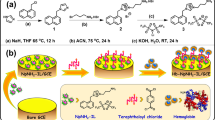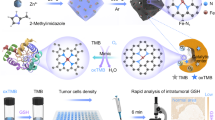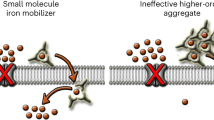Abstract
Hemoglobin (Hb) and myoglobin (Mb) are heme proteins that capture and transport molecular oxygen (O2) in living organisms. Although mimicking the O2-binding function of Hb and Mb using synthetic iron-porphyrin has been extensively studied for over 40 years, mimicking the function of Hb/Mb in vivo or 100% aqueous solutions has been minimally studied. Hence, a supramolecular complex termed “hemoCD1” was constructed as the aqueous synthetic Hb/Mb model using a 1:1 inclusion complex of 5,10,15,20-tetrakis(4-sulfonatophenyl)porphinatoiron(II) (FeIITPPS) with a per-O-methylated β-cyclodextrin dimer with a pyridine linker (Py3CD). Selective carbon monoxide (CO) depletion in vivo is beneficial for studying the physiological roles of endogenous CO as a gaseous signal messenger. HemoCD1 reversibly binds O2 and CO in aqueous solution at ambient temperature. Hence, hemoCD1 was used as a selective CO scavenger in vivo due to its extremely high binding affinity to CO. In addition, hemoCD1 was utilized to quantify the accumulation of endogenous and exogenous CO in organs/tissues. Finally, hemoCD1 was employed as an antidote for CO poisoning in animals. Thus, recent developments in hemoCD1 have revealed that the aqueous biomimetic heme protein model has significant physiological and therapeutic application potential.
This is a preview of subscription content, access via your institution
Access options
Subscribe to this journal
Receive 12 print issues and online access
$259.00 per year
only $21.58 per issue
Buy this article
- Purchase on Springer Link
- Instant access to full article PDF
Prices may be subject to local taxes which are calculated during checkout








Similar content being viewed by others
References
Reedy CJ, Gibney BR. Heme protein assemblies. Chem Rev. 2004;104:617–49.
Kühl T, Imhof D. Regulatory FeII/III heme: the reconstruction of a molecule’s biography. Chembiochem. 2014;15:2024–35.
Shimizu T, Huang D, Yan F, Stranava M, Bartosova M, Fojtíková V, et al. Gaseous O2, NO, and CO in signal transduction: structure and function relationships of heme-based gas sensors and heme-redox sensors. Chem Rev. 2015;115:6491–533.
Shimizu T, Lengalova A, Martínek V, Martínková M. Heme: emergent roles of heme in signal transduction, functional regulation and as catalytic centres. Chem Soc Rev. 2019;48:5624–57.
Collman JP, Boulatov R, Sunderland CJ, Fu L. Functional analogues of cytochrome c oxidase, myoglobin, and hemoglobin. Chem Rev. 2004;104:561–88.
Huang X, Groves JT. Oxygen activation and radical transformations in heme proteins and metalloporphyrins. Chem Rev. 2018;118:2491–553.
Adam SM, Wijeratne GB, Rogler PJ, Diaz DE, Quist DA, Liu JJ, et al. Synthetic Fe/Cu complexes: toward understanding heme-copper oxidase structure and function. Chem Rev. 2018;118:10840–1022.
Wagener FADTG, Eggert A, Boerman OC, Oyen WJG, Verhofstad A, Abraham NG, et al. Heme is a potent inducer of inflammation in mice and is counteracted by heme oxygenase. Blood. 2001;98:1802–11.
Balla J, Vercellotti GM, Jeney V, Yachie A, Varga Z, Eaton JW, et al. Heme, heme oxygenase and ferritin in vasculae endothelial cell injury. Mol Nutr Food Res. 2005;49:1030–43.
Kumar S, Bandyopadhyay U. Free heme toxicity and its detoxification systems in human. Toxicol Lett. 2005;157:175–88.
Gozzelino R, Jeney V, Soares MP. Mechanisms of cell protection by heme oxygenase-1. Annu Rev Pharm Toxicol. 2010;50:323–54.
Roumenina LT, Rayes J, Lacroix-Desmazes S, Dimitrov JD. Heme: modulator of plasma systems in hemolytic diseases. Trends Mol Med. 2016;22:200–13.
Kitagishi H, Kano K. Synthetic heme protein models that function in aqueous solution. Chem Commun. 2021;57:148–73.
Kano K, Kitagishi H, Kodera M, Hirota S. Dioxygen binding to a simple myoglobin model in aqueous solution. Angew Chem Int Ed. 2005;44:435–8.
Kano K, Kitagishi H, Dagallier C, Kodera M, Matsuo T, Hayashi T, et al. Iron porphyrin-cyclodextrin supramolecular complex as a functional model of myoglobin in aqueous solution. Inorg Chem. 2006;45:4448–60.
Collman JP, Gagne RR, Halbert TR, Marchon JC, Reed CA. Reversible oxygen adduct formation in ferrous complexes derived from a picket fence porphyrin. A model for oxymyoglobin. J Am Chem Soc. 1973;9:7868–70.
Collman JP, Gagne RR, Reed CA, Robinson WT, Rodley GA. Structure of an iron(II) dioxygen complex; a model for oxygen carrying hemeproteins. Proc Natl Acad Sci USA. 1974;71:1326–9.
Collman JP. Synthetic models for the oxygen-binding hemoproteins. Acc Chem Res. 1977;10:265–72.
Collman JP, Fu L. Synthetic models for hemoglobin and myoglobin. Acc Chem Res. 1999;32:455–63.
Jameson GB, Ibers JA. Biological and synthetic dioxygen carriers. In: Bertini I, Gray HB, Lippard SJ, Valentine JS, editors. Bioinorganic chemistry. Mill Valley, CA: University Science Books; 1994. p. 167–251.
Momenteau M, Reed CA. Synthetic heme dioxygen complexes. Chem Rev. 1994;94:659–98.
Rose E, Lecas A, Quelquejeu M, Kossanyi A, Boitrel B. Synthesis of biomimetic heme precursors. Coord Chem Rev. 1998;180:1407–31.
Lombardi A, Nastri F, Pavone V. Peptide-based heme-protein models. Chem Rev. 2001;101:3165–89.
Boitrel B, Le, Gac S. Stabilization of synthetic heme-superoxo complexes by hydrogen bonding: a still on-going quest. N J Chem. 2018;42:7516–21.
Zaragoza JPT, Goldberg DP. Dioxygen binding and activation mediated by transition metal porphyrinoid complexes. In: Ikeda-Saito M, Raven E, editors. Dioxygen-dependent heme enzymes. Cambridge, UK: The Royal Society of Chemistry; 2018. p. 1–36.
Jiang D-J, Aida T. A dendritic iron porphyrin as a novel haemoprotein mimic: effects of the dendrimer cage on dioxygen-binding activity. Chem Commun. 1996;1523;1523–4.
Komatsu T, Hayakawa S, Tsuchida E, Nishide H. meso-Tetrakis[o-(N-methyl)pyridinium]porphyrin ensembles with axially coordinated cyclodextrin-penetrating phenethylimidazole: reversible dioxygen-binding in aqueous DMF solution. Chem Commun. 2003;50–1.
Collman JP, Fu L, Zingg A, Diederich F. Dioxygen and carbon monoxide binding in dendritic iron(ii)porphyrins. Chem Commun. 1997;193–4.
Zingg A, Felber B, Gramlich V, Fu L, Collman JP, Diederich F. Dendritic iron(II) porphyrins as models for hemoglobin and myoglobin: specific stabilization of O2 complexes in dendrimers with H-bond-donor centers. Helv Chim Acta. 2002;85:333–50.
Tsuchida E, Komatsu T, Arai K, Yamada K, Nishide H, Furhop J. Self-assembled lipidporphyrin bilayer vesicles. Microstructure and dioxygen binding in aqueous medium. Langmuir. 1995;11:1877–84.
Komatsu T, Yanagimoto T, Furubayashi Y, Wu J, Tsuchida E. Self-assembled fibers made of lipidporphyrinato–zinc(II) and –iron(II) complexes with an intramolecular coordinated axial imidazole. Langmuir. 1999;15:4427–33.
Tsuchida E, Komatsu T, Arai K, Yamada K, Nishide H, Böttecher C, et al. Monolayered octopus-porphyrin vesicle: microstructure and oxygen-binding in aqueous medium. J Chem Soc Chem Commun. 1995:10634.
Kano K, Tanaka N, Minamizono H, Kawakita Y. Tetraarylporphyrins as probes for studying mechanism of inclusion-complex formation of cyclodextrins. Effect of microscopic environment on inclusion of ionic guests. Chem Lett. 1996;925–6.
Kano K, Nishiyabu R, Asada T, Kuroda Y. Static and dynamic behavior of 2:1 inclusion complexes of cyclodextrins and charged porphyrins in aqueous organic media. J Am Chem Soc. 2002;124:9937–44.
Kano K, Kitagishi H, Tamara S, Yamada A. Anion binding to a ferric porphyrin complexed with per-O-methylated β-cyclodextrin in aqueous solution. J Am Chem Soc. 2004;126:15202–10.
De Rosa MC, Bertonati C, Giardina B, Di Stasio E, Brancaccio A. The effect of anions on azide binding to myoglobin: an unusual functional modulation. Biochim Biophys Acta. 2002;1594:341–52.
Hirota S, Ogura T, Appelman EH, Shinzawa-Itoh K, Yoshikawa S, Kitagawa T. Observation of a new oxygen-isotope-sensitive Raman band for oxyhemoproteins and its implications in heme pocket structures. J Am Chem Soc. 1994;116:10564–70.
Kitagishi H, Negi S, Kiriyama A, Honbo A, Sugiura Y, Kawaguchi AT, et al. A diatomic molecule receptor that removes CO in a living organism. Angew Chem Int Ed. 2010;49:1312–5.
Mao Q, Kawaguchi AT, Mizobata S, Motterlini R, Foresti R, Kitagishi H. Sensitive quantification of carbon monoxide in vivo reveals a protective role of circulating hemoglobin in CO intoxication. Commun Biol. 2021;4:425.
Ryter SW, Otterbein LE. Carbon monoxide in biology and medicine. Biossays. 2004;26:270–80.
Ryter SW, Alam J, Choi AMK. Haem oxygenase-1/carbon monoxide: from basic science to therapeutic applications. Physiol Rev. 2006;86:583–650.
Wu L, Wang R. Carbon monoxide: endogenous production, physiological functions, and pharmacological applications. Pharm Rev. 2005;57:585–630.
Mustafa AK, Gadalla MM, Snyder SH. Signaling by gasotransmitters. Sci Signal. 2009;2:re2.
Fukuto JM, Carrington SJ, Tantillo DJ, Harrison JG, Ignarro LJ, Freeman BA, et al. Small molecule signaling agents: the integrated chemistry and biochemistry of nitrogen oxides, oxides of carbon, dioxygen, hydrogen sulfide, and their derived species. Chem Res Toxicol. 2012;25:769–93.
Mann BE, Motterlini R, Foresti R. CO and NO in medicine. Chem Commun. 2007;4197–208.
Motterlini R, Otterbein LE. The therapeutic potential of carbon monoxide. Nat Rev Drug Disco. 2010;9:728–43.
Motterlini R, Foresti R. Biological signaling by carbon monoxide and carbon monoxide-releasing molecules. Am J Physiol Cell Physiol. 2017;312:C302.
Ling K, Men F, Wang W-C, Zhou Y-Q, Zhang H-W, Ye D-W. Carbon monoxide and its controlled release: therapeutic application, detection, and development of carbon monoxide releasing molecules (CORMs). J Med Chem. 2018;61:2611–35.
Kitagishi H, Minegishi S, Yumura A, Negi S, Taketani S, Amagase Y, et al. Feedback response to selective depletion of endogenous carbon monoxide in the blood. J Am Chem Soc. 2016;138:5417–25.
Kitagishi H, Minegishi S. Iron(II)porphyrin–cyclodextrin supramolecular complex as a carbon monoxide-depleting agent in living organisms. Chem Pharm Bull. 2017;65:336–40.
Freeman SL, Kwon H, Portolano N, Parkin G, Venkatraman Girija U, Basran J, et al. Heme binding to human CLOCK affects interactions with the E-box. Proc Natl Acad Sci USA. 2019;116:19911–6.
Dioum EM, Rutter J, Tuckerman JR, Gonzalez G, Gilles-Gonzalez M-A, McKnight SL. NPAS2: a gas-responsive transcription factor. Science. 2003;298:2385–7.
Lukat-Rodgers GS, Correia C, Botuyan MV, Mer G, Rodgers KR. Heme-based sensing by the mammalian circadian protein CLOCK. Inorg Chem. 2010;49:6349–65.
Klemz R, Reischl S, Wallach T, Witte N, Jürchott K, Klemz S, et al. Reciprocal regulation of carbon monoxide metabolism and the circadian clock. Nat Struct Mol Biol. 2017;24:15–22.
Bass J, Lazar MA. Circadian time signatures of fitness and disease. Science. 2016;354:994–9.
Boehning D, Snyder SH. Carbon monoxide and clocks. Science. 2002;298:2339–40.
Minegishi S, Sagami I, Negi S, Kano K, Kitagishi H. Circadian clock disruption by selective removal of endogenous carbon monoxide. Sci Rep. 2018;8:11996.
Minegishi S, Yumura A, Miyoshi H, Negi S, Taketani S, Motterlini R, et al. Detection and removal of endogenous carbon monoxide by selective and cell-permeable hemoprotein-model complexes. J Am Chem Soc. 2017;139:5984–91.
Goldbaum LR, Ramirez RG, Absalon KB. What is the mechanism of carbon monoxide toxicity? Aviat Space Environ Med. 1975;46:1289–91.
Vreman HJ, Wong RJ, Kadotani T, Stevenson TK. Determination of carbon monoxide (CO) in rodent tissue: effect of heme administration and environmental CO exposure. Anal Biochem. 2005;341:280–9.
Chaves-Ferreira M, Albuquerque IS, Matak-Vinkovic D, Coelho AC, Carvalho SM, Saraiva LM, et al. Release from RuII(CO)2–protein complexes in aqueous solution, cells, and mice. Angew Chem Int Ed. 2015;54:1172–5.
Brown SD, Piantadosi CA. In vivo binding of carbon monoxide to cytochrome c oxidase in rat brain. J Appl Physiol. 1985;68:604–10.
Piantadosi CA, Zhang J, Levin ED, Folz RJ, Schmechel DE. Apoptosis and delayed neuronal damage after carbon monoxide poisoning in the rat. Exp Neurol. 1997;147:103–14.
Acknowledgements
This work was financially supported by JSPS KAKENHI Grant Numbers 20H02871, 20H04540, 19K22972, and 18KK0156, the MEXT-Supported Program for the Strategic Research Foundation at Private Universities (2015–2019), the Takeda Science Foundation, the NOVARTIS Foundation (Japan) for the Promotion of Science, the Suntory Foundation for Life Sciences, and the JGC-S Scholarship Foundation.
Author information
Authors and Affiliations
Corresponding author
Ethics declarations
Conflict of interest
The authors declare no competing interests.
Additional information
Publisher’s note Springer Nature remains neutral with regard to jurisdictional claims in published maps and institutional affiliations.
Rights and permissions
About this article
Cite this article
Kitagishi, H., Mao, Q. Capture of carbon monoxide using a heme protein model: from biomimetic chemistry of heme proteins to physiological and therapeutic applications. Polym J 54, 465–472 (2022). https://doi.org/10.1038/s41428-021-00591-y
Received:
Revised:
Accepted:
Published:
Issue Date:
DOI: https://doi.org/10.1038/s41428-021-00591-y
This article is cited by
-
Special issue: Fundamentals and applications of carbohydrate polymers
Polymer Journal (2022)



